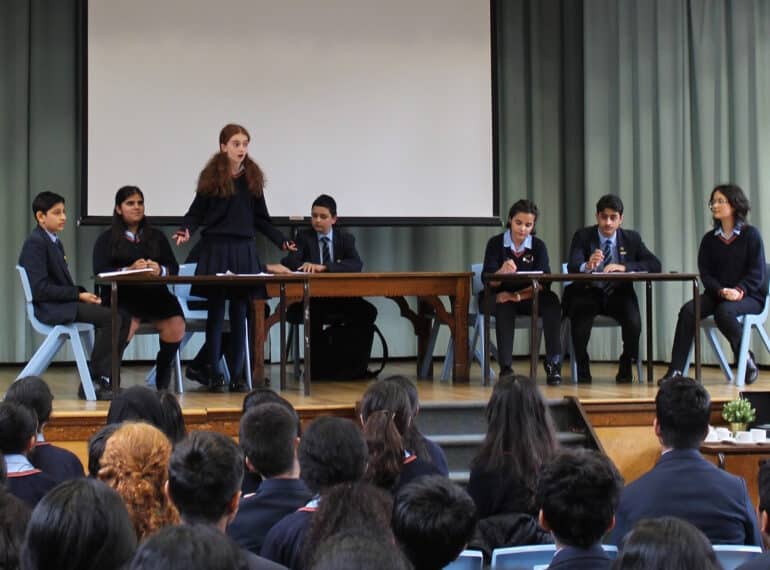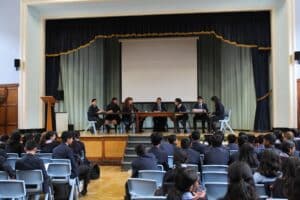
QE boys teamed up with pupils from a local leading girls’ school for a morning of enthusiastic debates on some of the hottest topics of the day.
 After the initial quickfire rounds, the morning with the guests from The Henrietta Barnett School (HBS) culminated in a final impassioned debate on the motion This House believes it was right to arrest the protesters at the King’s coronation.
After the initial quickfire rounds, the morning with the guests from The Henrietta Barnett School (HBS) culminated in a final impassioned debate on the motion This House believes it was right to arrest the protesters at the King’s coronation.
Hosted by QE, the debating challenge was attended by 144 selected Year 8 pupils from the two schools.
Headmaster Neil Enright said: “Our academic partnership with HBS provides a valuable opportunity for large numbers of our boys to work alongside young women, whether in subject-related symposia or, as on this occasion, in engaging with them in topical and political discussions.
“When it comes to developing your skills in debating, there is nothing like having to stand in front of a large audience – including many people that you don’t know – after a very limited preparation time and talking about something of which you may not have deep knowledge, setting out an argument concisely and then defending it adroitly when challenged!
“Such experiences constitute an important preparation for working alongside both women and men in pupils’ later lives, whether in higher education or in their careers.”
After the HBS pupils arrived at the start of the morning, they and the boys were split into six mixed groups in different rooms and given 20 minutes to work together using previously prepared material.
The event was run according to the ‘extended Mace format’, based on the long-running universities debating competition known originally as the Observer Mace. In this format, the debate is opened to audience participation after the first round of opening statements and rebuttals.
There were eight teams, comprising three debaters each, who took part in four debates. Other roles were a chair, who was responsible for keeping order and running the debate, a timekeeper and two reporters in each group, who took notes and helped teachers picked the best debater from their room.
Four debates took place over a period of 90 minutes. The motions debated were:
- This House would use animals for experimentation
- This House believes 16-year-olds should have the right to vote
- This House believes that all owners of large dogs should have to pass a test to prove they are able to control them
- This House would abolish homework.
After a break, the final debate took place in the Main Hall, featuring the best debaters from each of the six groups.
They were again given just 20 minutes to prepare. An initial vote indicated a roughly even split in the audience between those for and against the motion.
After the side arguing for the motion – the ‘Proposition’ – argued that the protest could have turned violent, the Opposition swiftly countered, pointing out that far from being violent, the protesters were not even disrupting the coronation, and adding that the police were, in fact, violating the protesters’ rights. The Proposition’s second speaker bolstered the arguments in favour of the motion by adducing the example of the Capitol riots in the USA.
When opened to the floor, there was a succession of attacks on the Proposition’s arguments, while the vagueness of the motion was itself criticised. After the audience debate, both sides summarised their arguments. A vote was again taken, and the result was now a landslide for the Opposition.
